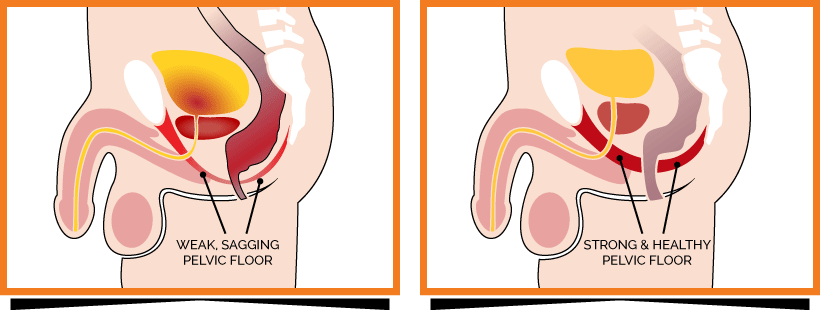Most men are not aware that they have a pelvic floor. But without it you would be unable to hold urine in your bladder or contract your bowels to prevent wind and faeces escaping, you will be unable to get an erection, and you could suffer from the symptoms of prostatitis. The pelvic floor and its functions within the body are a necessity. They help to keep a variety of pelvic health problems at bay.
Contents
What Is The Male Pelvic Floor?
The pelvic floor is made up of layers of muscle, tissue, and ligaments. These layers stretch from the tailbone of your lower back, to your pubic bone in the front. They act as a supportive sling for your bladder and bowel, with your urethra and rectum passing through. The prostate surrounds the urethra and can enlarge as men age.

Why Is The Male Pelvic Floor Important?
The male pelvic floor muscles are extremely important for the control of your bladder and bowel. The muscles help to prevent the leakage of urine, faeces, or wind, by keeping the bladder and bowel openings closed, especially after treatment for prostate issues. They are also important in the process of passing urine and faeces, as the muscles relax to allow the function.
The muscles also play an essential role in erectile function during intercourse. Toned pelvic floor muscles help maintain long and strong erections, and can also prevent premature ejaculation.
How Do You Maintain the Male Pelvic Floor?
Maintaining a strong pelvic floor is vital for your body to function correctly. Strengthening your pelvic floor is the NHS-endorsed way to cure male pelvic floor disorders, such as Incontinence and Erectile Dysfunction. There are a variety of ways to improve, strengthen and maintain your pelvic floor muscles, such as:

- Male Kegels - Otherwise known as pelvic floor exercises, male Kegels are the best way to strengthen and protect your pelvic floor. You can exercise your pelvic floor manually with Kegels, or alternatively, you can use an electronic male pelvic toner. To learn more about exercising your pelvic floor muscles, visit Male Pelvic Floor Treatment for more information.
- Posture - It's well known that bad posture leads to bad back pain, but it also leads to a bad pelvic floor too! When your core muscles are relaxed, your pelvic floor muscles also slacken, causing them to grow weaker over time. It's been medically proven that the more upright your posture is, the stronger the effect of pelvic floor exercise. Light strengthening exercises, such as yoga and swimming, can help to improve your posture. alternatively, try using a posture cushion on your chair to avoid slouching.
- Vitamins - To keep your pelvic floor strong, ensure you get enough vitamin D. Research has shown that people with sufficient levels of vitamin D are 45% less likely to develop incontinence as it supports the muscle strength.
- Weight - Being an unhealthy weight can have a negative effect on your pelvic floor. The extra weight can cause extra pressure inside of you, putting a strain on your pelvic floor muscles, gradually making them weaker.
- Bowel Health - Constipation can put a lot of excess pressure on your pelvic floor. Straining too often can lead to faecal incontinence! Around 50% of people with chronic constipation end up with a variant of a pelvic floor dysfunction. To tackle this, make sure you are including fibre-rich food within your diet, such as wholegrain and brown rice. Another way to avoid straining is to use a toilet stool. By changing your position on the toilet, you create an angle that opens up your bowels, simultaneously protecting your pelvic floor.
- Breathing - When you breathe in deeply, your diaphragm and internal organs get pushed down, gently stretching your pelvic floor muscles. By breathing this way throughout the day, you can exercise your pelvic floor automatically.
How to Find Your Pelvic Floor Muscles
Before you begin exercising your pelvic floor muscles, you'll first need to locate them. To do this, you can either sit, stand, or lie down - depending which is the most comfortable - and relax your thighs, stomach, and bum.
- Tighten the muscle around the opening of your anus, as if you're trying not to pass wind - then relax. Try not to squeeze your buttocks together or clench your stomach or thigh muscles.
- At the same time, imagine that you are urinating. Tighten your muscles as if you are trying to stop mid-flow, then relax. It might help to try this once or twice whilst you're urinating if it helps you to find the right muscles - but don't do this regularly as it could cause bladder problems.
- You can check if you're using the right muscles by placing your fingertips on the skin behind your scrotum. You'll feel the muscles lift away from your fingers each time you tighten if you're using the right muscles. If you feel that the muscles are pushing down, then you are not doing the exercises correctly. You may also find it helpful to do the exercises in front of a mirror to begin with as you'll be able to see the base of your penis and your scrotum move.
To learn more about doing male pelvic floor exercises, click here.
What Are The Problems Associated with the Male Pelvic Floor?
although it plays a strong role in your bodily functions, the male pelvic floor is fragile. There are a multitude of problems that are associated with a weak male pelvic floor. A few of these include:
- Chronic Pelvic Pain
- Incontinence
- Pelvic Organ Prolapse
- Erectile Dysfunction
- Prostate Cancer Treatment
To learn more about the causes of male pelvic problems and how to identify the symptoms, click here.
Sources
Cohen, D. Goldstein, I. Gonzalez, J. (2016). Sexual Medicine Reviews. The Role of Pelvic Floor Muscles in Male Sexual Dysfunction and Pelvic Pain. [online] 4, pp. 53-62. [viewed 03/04/2018]. Available from: http://www.smr.jsexmed.org/article/S2050-0521(15)00002-5/pdf.
Department of Health (2016) Pelvic Floor Muscle Training for Men [online] DoH Australia [viewed 01/08/2018]. Available from http://www.bladderbowel.gov.au/adults/pelvicmen.htm.
Elneil, S. (2009) Complex Pelvic Floor Failure and Associated Problems. Best Practice and Research Clinical Gastroenterology. 23(4), pp. 555-573.
Mayo Clinic (2015) Kegel Exercises for Men: Understand the Benefits [online] Mayo Clinic [viewed 01/08/2018]. Available from https://www.mayoclinic.org/healthy-lifestyle/mens-health/in-depth/kegel-exercises-for-men/art-20045074.
NHS (2014) A Guide to the Pelvic Floor Muscles - Men [online]. NHS [viewed 02/08/2018]. Available from https://www.ouh.nhs.uk/patient-guide/leaflets/files/11124Ppelvic.pdf
NHS (2017) What are Pelvic Floor Exercises? [online]. NHS [viewed 30/08/2018]. Available from https://www.nhs.uk/common-health-questions/womens-health/what-are-pelvic-floor-exercises/
Prostate Cancer UK (2014) Pelvic Floor Muscle Exercises [online]. Prostate Cancer UK [viewed 01/08/2018]. Available from https://prostatecanceruk.org/media/975926/pelvic_floor_exercises-ifm.pdf.



